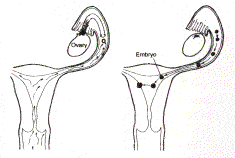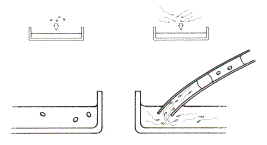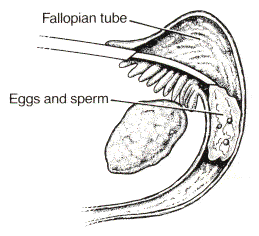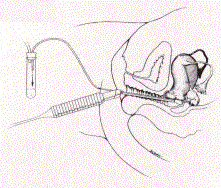GIFT was an early, and very simple ART (Assisted Reproductive Technology) technique devised in the 1980s that is nor rarely employed. Most infertility patients will have their best chance of pregnancy with some sort of ART procedure, and GIFT is still the only ART approach that is completely acceptable to the Roman Catholic Church. GIFT can be performed only if the patient has normal fallopian tubes and adequate sperm. For cases with abnormal fallopian tubes, IVF is mandated. For cases with poor sperm, we recommend the ICSI procedure pioneered by us and our Belgian collaborators. In the present era, GIFT is only of historical interest.
GIFT stands for “Gamete Intra-Fallopian Transfer.” Gametes, i.e., the female’s eggs and the male’s sperm, are washed and placed via a catheter directly into the woman’s fallopian tubes. This usually involves a surgical procedure with some degree of pain that lasts for about a week. With GIFT, fertilization occurs inside the woman’s body (not outside), and mimics the way a normally fertilized egg would begin its journey to the uterus for implantation. Understanding this older ART treatment is helpful for understanding the newer, more complex treatments.
How Does GIFT Work?

Right: Implantation in uterus
In a fertile couple, pregnancy begins with the release of an ovum (egg) from the woman’s ovaries. The egg enters the fallopian tube where it meets with sperm that have traveled there, following intercourse, from the vagina. The sperm normally fertilize the egg in the fallopian tube. The fertilized egg, now called an embryo, begins to divide and in four days, contains many cells. At this time, the embryo moves from the fallopian tube to the uterine cavity where it “floats” for another two days. The embryo then implants in the uterine wall, and becomes a pregnancy.
The GIFT technique allowed the eggs to fertilize and develop in the fallopian tube, and then to make their way to the uterus for implantation according to a normal timetable. In contrast, in vitro fertilization (IVF) places fertilized eggs directly into the uterus. The problems with GIFT that IVF has solved, include that GIFT requires surgery and you don’t know if the eggs are fertilized. It is interesting to discuss this older procedure even though it is rarely used today.

Prior to any GIFT, IVF, or ICSI procedure, the woman receives hormones to stimulate development of the ovarian follicles, which are sac-like structures that contain the eggs. Administering these hormones allows us to retrieve many ripened eggs, and thus increase the chance of pregnancy.
Approximately three hours before the procedure, a semen sample from the husband is obtained. The sperm is washed and prepared for loading into the same catheter into which several of the wife’s best eggs will be placed. The eggs are obtained by transvaginal needle aspiration (no surgical incision) via an ultrasound guide.
The fluid containing the eggs is placed in a laboratory dish and observed under a microscope. The egg is located and its stage of maturity noted. It is then carefully cultured in a special nutrient. Sperm and eggs are sequentially loaded into a catheter, which is then introduced into the patient’s fallopian tube through an operative incision in her abdomen, under general anesthesia.

The eggs and sperm are then released into the fallopian tube. The number of eggs returned to the patient depends on the wife’s age and egg quality. This procedure can be performed surgically either through laparoscopy or a small, one-inch “mini-lap” incision in the lower abdomen, under general anesthesia. It takes place in our technologically advanced operating room and lab, with a highly controlled environment to prevent any inadvertent toxicity to the eggs, sperm, or embryos.
If you have any questions, you may call us at (314) 576-1400.

